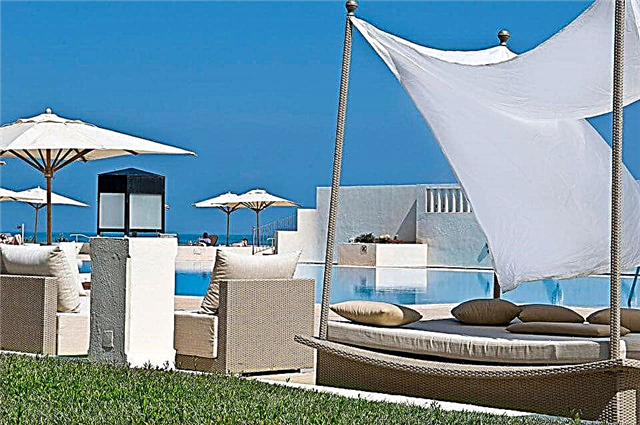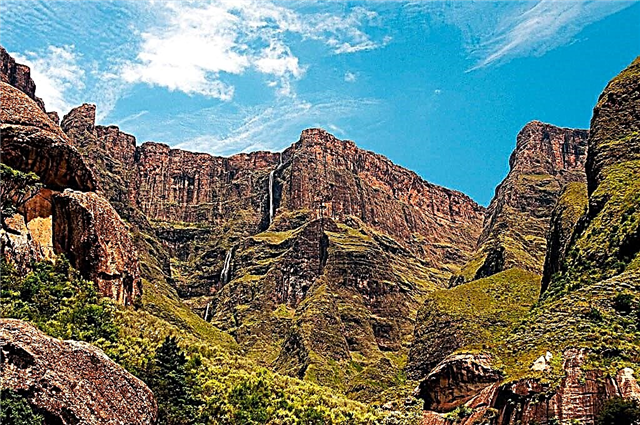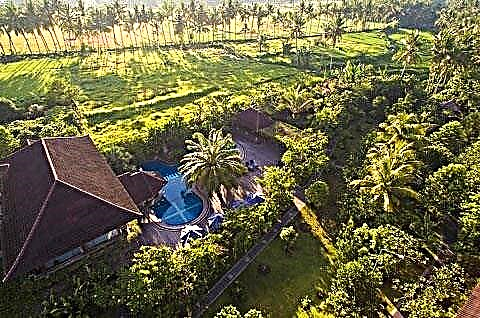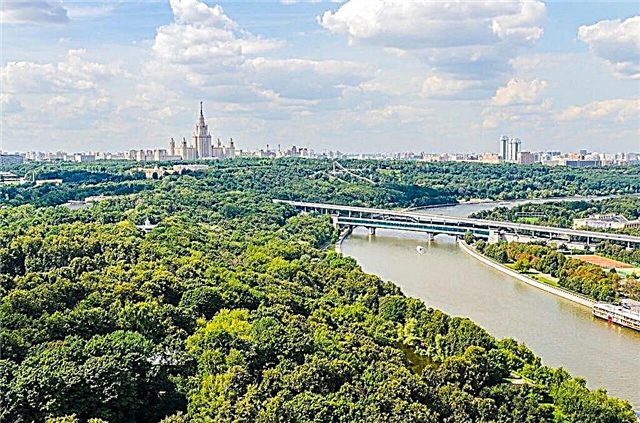Vorobyovy Gory is one of the key sights of Moscow. By their nature, they represent a hill on the banks of the Moskva River and are the main observation deck of the capital of Russia. From the top of the hill there is a picturesque panorama of a dense forest, a park area, architectural buildings, structures and temples are visible. On the observation deck, the soul of Moscow, its strength, grace and grandeur, is revealed to the residents and guests of the city. A lot of festive and cultural events are held in this unique place. Muscovites and tourists come here to relax, take pictures, play sports, and also seek inspiration and peace.
History

In the XIV century, the village of Vorobyovo was located on the modern territory of Vorobyovy Gory. It belonged to the Vorobyov boyars. In 1453, the wife of the Moscow prince Vasily I, princess Sofya Vitovna, bought the village from the noble owners, where the estate was built. This is how the Sparrow Palace was erected.
Later it was the summer residence of the Grand Dukes of Moscow and All Russia Ivan III, Vasily III, Ivan IV the Terrible, as well as the Tsar of All Russia Alexei Romanov. Young Peter I loved to come to the village of Vorobyovo. Here he repeatedly conducted military exercises with his "amusing army". The territory of the Sparrow Hills has long been famous for its beautiful white sand. Thanks to this, Peter I initiated the construction of the first mirror glass factory in Moscow on this site.
During the reign of Catherine II, the architect Matvey Kazakov took up the rebuilding of residential and public buildings in Moscow. A palace on Prechistenskaya Street was built especially for the Empress, who came to the celebrations in honor of the victory of the Russian troops over the Ottomans. However, the location of the building turned out to be inconvenient for the royal person.
At the end of the festive events, by decree of Ekaterina Alekseevna, it was decided to move the Prechistensky Palace from the center of Moscow to the village of Vorobyovo. Under the supervision of M. Kazakov, the building structures were delivered by barges along the Moskva River. Thus, a new palace appeared on the site of the old manor, which had fallen into disrepair. But none of the Romanovs ever lived there. In 1812, the residence burned down. Nothing was built on this site for a long time.
In honor of the victory of Russia in the Patriotic War over Napoleon, Emperor Alexander I issued a decree on the construction of the Cathedral of Christ the Savior. The sovereign approved the project of the architect Alexander Vitberg. According to the plan, the construction of the structure was supposed to begin on Vorobyovy Gory. According to the architect's plan, the temple should be built of marble limestone.
Raw materials were mined a few kilometers from the Sparrow Hills, so the marble was delivered by barges along the river. The building was built slowly due to the unstable soil base and soon ceased altogether. In addition, fraudulent schemes of theft of local officials were revealed. All this became the reason for the termination of the construction of the temple on Sparrow Hills.

Before the revolution there was a restaurant on Sparrow Hills. The institution was very popular among Muscovites and guests. The spacious terrace was located on an elevated slope, from where a stunning view of Moscow opened up. The famous singer Fyodor Chaliapin often visited here, who delighted the audience with his talent. During the Soviet era, the Sparrow Hills began to flourish.
The territory began to be transformed into a park and sports and entertainment zone. There were erected: a ski slope, a springboard and a funicular. An observation deck has been equipped. In the mid-1950s, the building of the Moscow State University and the Luzhniki stadium were built. Since then, Vorobyovy Gory has become a truly cult and favorite vacation spot for Soviet youth.
Observation deck today

It is difficult to find a more suitable and generally accessible place for admiring the central part of Moscow than the observation deck on Vorobyovy Gory. The large-scale panorama is impressive and breathtaking. A large number of unique historical sights are covered with a single glance. If you equip yourself with binoculars, you can see in detail the appearance of the capital of Russia. Behind the terrace rises the building of the Moscow State University, surrounded by a large garden.
The observation deck offers a view of a dense forest, the Moskva River embankment. In the center of the panorama is the grandiose Luzhniki stadium. Behind the bowl of the arena you can see the domes of St. Basil's Cathedral and the Cathedral of Christ the Savior. To the left are the modern skyscrapers of the business center of the capital, as well as the Ostankino Tower, the House of the Government of the Russian Federation and the building of the Ministry of Foreign Affairs.
On the right side there is a two-level arched Luzhnetsky metro bridge intended for cars and the subway. Behind the bridge you can see the twenty-two-story building of the Russian Academy of Sciences and the famous Shabolovskaya tower.
What to see
Sparrow Hills are the main observation deck of the capital. An unusually beautiful panorama of the Kremlin opens from a high place on the steep bank of the Moskva River. One of the most beautiful places has preserved the ancient atmosphere hidden in the streams of healing springs, on the paths of the pristine forest, in the tales and legends about the life of the first inhabitants of the area. Modern man-made structures, architectural masterpieces complete the list of attractions.
Main building of Moscow State University

The monumental building in the Stalinist Empire style is considered one of the architectural symbols of Moscow. This is the highest skyscraper out of 7 unique buildings of those times. Together with the openwork spire, the height of the building is 240 m. Until 1990, the building was the tallest building in Europe. Construction took place from 1949 to 1953.
The facades were designed by specialists from the workshop of Vera Mukhina. Architectural elements, expensive finishing materials were determined in accordance with the current ideology. The entire appearance of the building confirmed the strength, power, the role of science, education in the young country. The site on a high plateau, allocated for the construction of the university, made it possible to create this unique ensemble.
According to the initial project, it was planned to make the main decoration of the spire in the form of a sculpture by Lomonosov. At Stalin's suggestion, it was completed with a star with yellow glass and aluminum amalgam. The entire infrastructure of the Main Building was created taking into account the needs of students and teachers. Now there is an indoor pool, several cafes, an assembly hall, and numerous auditoriums for students. And in front of the building is the largest square in the capital.
Botanical Garden of Moscow State University

The territory of the university covers an area of about 168 hectares. The main part is a green area in the form of parks, squares, green boulevards. Among them, a huge place is occupied by the Botanical Garden of the University. The territory for it was determined in October 1950. The organization of the life of the special zone was formed according to the type of the Pharmaceutical Garden in the area of Prospect Mira (now it is a branch of the Botanical Garden of Moscow State University).
The educational and scientific activities of the Faculty of Biology of the University are organized in the protected area. Unique collections of natural and garden plants have been created. Special landing strips are made of tall coniferous trees. They reliably protect the plantings of heat-loving species. There is an interesting rock garden in the central part of the garden. It was built on the basis of granite blocks brought from Karelia.
The terraces of the rock garden repeat the landscape of different mountain systems with their own collections of plants. At the top of the rock garden, snow-white water lilies bloom in a lake formed in a convenient basin. The highest point of the rock garden is located above the surface of the lake surface.In special areas of the Botanical Garden, work is being carried out to obtain new varieties of different plants.
In a beautiful apple orchard, a crop of rare, reliable varieties ripens annually. If you're lucky, you can buy a rare apple stalk.
Aqua complex "Luzhniki"

On the squares of the huge sports complex of Russia, there are new buildings of the Palace of Water Sports. Among them there are 9 pools, whirlpools, water slides. The water park is considered the largest indoor water entertainment palace in Russia. About 2000 people can rest in it at the same time. Visitors can be on 6 levels for different purposes throughout the day.
The first floor is occupied by a shopping center and a new simulator for creating artificial waves. They can be trained by professional participants. On the second floor there is a water park with water slides, a children's playground, a 50 m swimming pool for sports competitions. The third floor is occupied by two 25 m swimming pools and a thermal complex.
The terms contain 8 types of baths, saunas, various options for a contrast shower, swimming pools, a beach space with sun loungers. For kids, a SPA area with a salt room, an artificial beach, and a playroom has been organized. Visitors get a dizzying sensation on the water slides on the 4th floor. Boxing academy, fitness center, cafe are located on the 5th floor. The popular Water Palace is located next to the Vorobyovy Gory metro stop.
Temple of the Life-Giving Trinity

Despite the difficult fate, this Temple has survived in its appearance, created in 1813. The mention of the Trinity Church in the village of Vorobyovo has come to us since 1453. At this time, Princess Sofya Vitovtovna bought the village. It was a wooden structure. In its place in 1811 a stone cathedral in the Empire style was built. The project was supervised by the architect Vitberg.
The church was created as a single-domed version with a two-tiered bell tower, portals decorated with slender columns. Even the decree banning bell ringing did not affect the work of the church. The village was not part of the city. Kutuzov prayed in the church, it was not destroyed by Napoleon's troops. The old interior of the church has been preserved. And now you can see a white-stone monument, erected in 1811 on the site of the altar of an ancient temple.
Powerful green domes carefully guard the shrines of the church. There are many icons from the 17th century among them. Including the icon of the Kazan Mother of God, "Quench my sorrows", "Burning bush", John the Baptist, St. Nicholas the Wonderworker. Regular services and the eternal ringing of bells continue to invite Orthodox believers and guests of the capital.
Vorobievskaya embankment

Walking around Moscow, guests and residents of the capital often come to Vorobyovy Gory. Getting off at the metro station with the same name, you can start a trip to an interesting place in the city next to its historical and natural sights. Going down a low staircase, you begin your acquaintance with one of the embankments of Moscow, located along the coast at the foot of the Sparrow Hills.
Their picturesque hills have always attracted people for relaxation and walks. A popular walking area appeared in 1911, when the river bank began to be improved. The construction of the embankment is closely connected with the appearance of many architectural structures on Vorobyovy Gory: a cable car, an observation deck, and the Luzhnetsky metro bridge.
In 1961, the pedestrian embankment was decorated with flower beds, paths, recreation areas, a pier for river ships. Near the river pier there is a sports equipment rental service and a number of cafes. The embankment is convenient for cycling, hiking, rollerblading, skateboarding or lying on the soft lawn, admiring the green outfit of the Sparrow Hills.
Andrew's ponds
Nowadays, a cascade of ponds is a decorative adornment of protected areas. Basically, they include the Bolshoi and Maly Andreevsky ponds. There is also the Lesnoy pond, where crucians still live, frogs croak, mighty reeds grow, snow-white water lilies bloom. Andreevsky ponds appeared during the construction of the St.Andrew Monastery in the late 18th and early 19th centuries.
Residents of a nearby village raised fish in artificially created reservoirs. Later they became part of the possessions of the Dolgorukov princes. Along the banks of the cascading ponds, there are gazebos for relaxation and picnic areas. The trail of the ecological trail is nearby. Not only ducks swim calmly on the water, but also small black dives with fiery eyes. Not in every pond they choose for themselves a habitat, reproduction.
Cable car

The first version of the cable car route appeared in 1953 with the aim of servicing the events of the Big Jump. It was a simple chairlift with two stations. It was dismantled in 2016. For the 2018 FIFA World Cup, a new cable car gleamed over the Moscow River. She linked the Luzhniki stadium and the observation deck.
The length of the cable car is 720 m. There are three stations on it: Luzhniki along the left bank of the river, and Novaya Liga on the right side. At the very top is the Vorobyovy Gory station. A special feature of the cable car is its dual purpose. In addition to the usual delivery of athletes, it provides interesting travel offers. The operation of two routes has been organized: sports (New League - Vorobyovy Gory) and tourist (Luzhniki - Vorobyovy Gory).
35 closed cabins have been installed for tourists. Each can accommodate 8 passengers. Separate VIP cabins are provided for important guests. A tradition has already been born to use them for the first trip of the newlyweds. There are 10 open-type chairlifts on the sports track. It is convenient to get there and carry the necessary sports equipment. During the trip, a bird's eye view opens up a panorama of the city with numerous attractions.
Ecological trail

Active leisure options include an interesting offer in the form of walking along specific ecological trails. Now many parks, forests, mountains, where tourists visit, have such routes. The first route of the ecological trail in Moscow was a proposal on the territory of the Vorobyovy Gory reserve. It appeared in 2005. The common path consists of three sections: "Andreevskie ponds", "On the slopes of Vorobyovy Gory", "On the terraces of Vorobyovy Gory".
For correct orientation, there are signs and information stands along the entire length. They reflect information about archeology, the history of the place. It tells in detail about the flora and fauna of the reserve. The walk can be done independently or together with an excursion. Along the entire length of the trail, there are wooden paths, decks for careful walking. Aviaries with rare decorative birds, cheerful and fearless squirrels are installed near the ponds. A hike along the ecological trail helps to discover many of the geological and natural features of this place.
Interesting Facts

It is impossible not to tell about interesting facts about this unique place. Among them, the following information:
- For some time they were called Lenin Hills. In 1999, the area received its original name.
- For a long time, the area was decorated with a grandiose wooden palace. For almost 200 years it was the residence of the kings.
- Archaeologists have found evidence that ancient tribes lived here. They used the richness of the area in the form of extraordinary white sand. For them, it served as blotting paper. They were the first to master glass production and traded in beads and jewelry made from their own glass.
- The Rublevsky water supply system was born here, which gave Moscow water. The building of the Vorobyovskoye reservoir still stands.
- Natural sources that carry information about the ancient Devonian Sea, on which the capital stands, are still valid. Among them is the source where the oath was given to “sacrifice his life for the chosen struggle” by Herzen and Ogarev.
- In the period from the 18th to the 19th century, there was a Persian of the Acute. Life in it is described in Herzen's Past and Thoughts.
- The shelling of the Kremlin in 1917 was carried out by the White Guards from the picturesque hills.
- It was originally planned to build the Cathedral of Christ the Savior here. Constant landslides, soil instability canceled plans.
- At st. Kosygin, 20, the remains of the escalator gallery have been preserved. Now the monument of the era of building socialism has been restored and supplemented with elements of a modern purpose.
How to get there

The transport infrastructure is well developed in Moscow. You can get from the city center to Vorobyovy Gory by different means of transport. The easiest way to get to the place is to use the metro service.
The exit from the Vorobyovy Gory metro station is located 80 meters from the observation terrace. A well-groomed asphalt path leads up the slope through a vast park area. In the summertime, silence reigns here, interrupted by the singing of birds. A green oasis dampens the city noise of the capital. In winter, you can see many people skiing down the snowy slope.
You can get there by river tram along the Moskva River. Swim to the pier at the foot of the slope, and then go up in the cable car to the viewpoint. It will not be difficult to get on buses of routes No. 57, No. 111, No. 113, No. 119, No. 661 to the stop "MGU", which is located next to the observation terrace. Sparrow Hills is a visiting card of Moscow.
The observation deck offers a beautiful view of the city. During the day, a wide view of the capital opens, and the evening view from the hill fascinates with the bright colors of city lights. The visit will leave an unforgettable experience in your memory.











